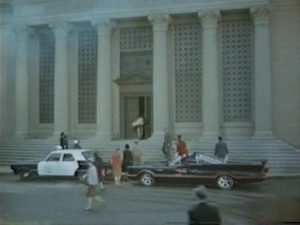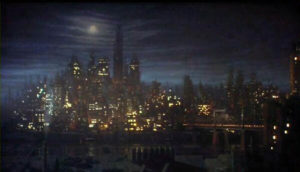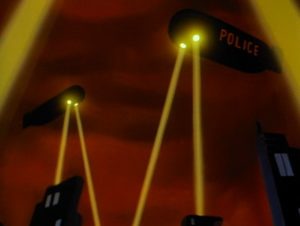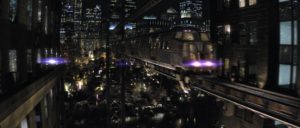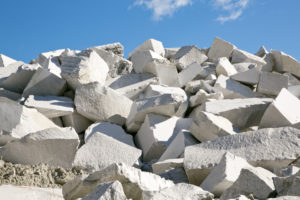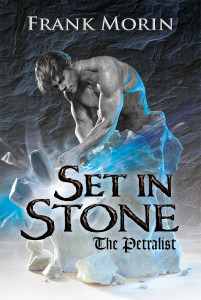For my second post this month I’d like to take a look at one of my favorite settings in all of media, Batman’s hometown of Gotham City. The angle I’d like to focus on is how writers and directors have used Gotham over the years, changing it like clay and sculpting so that the city is a reflection of the hero who protects it.
As Gotham changes, so does Batman. It’s more that just a fun exercise- -I think there is a lot here that we as writers can learn about using our settings to better frame our characters.
CONSISTENCIES OF THE SETTING
Let’s first take a look at four elements that stay consistent about Gotham in most interpretations:
The first two are somewhat trivial – Gotham is almost always shown as a coastal city in someway, and it is always located northern enough to get snow. The first one I suppose is to allow good waterfront scenes (and sell Batboat toys), while the latter allows you to have fun winter holiday issues.
The other two are more significant, and I think both tie to unchangeable elements of the Batman character.
- Gotham City is always represented as a very large city, both in population and geography.
- Gotham City is ridden with crime
I find these two very interesting, as I think they are interconnected to create a setting where Batman is a necessary element. Gotham is consistently depicted as a New York level city, in terms of population. This is as opposed to say Portland, Maine. We’re not talking about a hundred thousand people, Batman protects a city of millions of people. In a smaller city or a less crime filled one, Batman might have a chance at actually winning his battle. But Gotham City is too big and too filled with crime and corruption. One man could never win his war against crime here, which makes Batman’s quest to do so all the more compelling and tragic.
He fights a war he knows he can never win, and will someday lose.
So with those consistent elements in check, let’s look at how various media has played with the other components of Gotham City, and how those changes in the setting are there to reflect the version of Batman that protects it.
BATMAN – TELEVISION (1966)
The narration for this television show lets you know from the very beginning. Gotham is a “fair city”. Wayne Manor is “stately”. Of all the takes on Gotham, this is by far the nicest. It’s even daylight outside for most of the shots! With its blue skies and clean streets, this Gotham reflects its Batman perfectly. There is no brooding Dark Knight here. This Bruce Wayne is a fairly happy person; being Batman is a mission to him, but not a curse or burden as it is in most other takes.
It is also worth noting that this is the most generic looking of the Gotham versions I will cover. Other than Wayne Manor and Police Headquarters there are no iconic exterior locations, which gives the city a ‘everytown’ feeling.
BATMAN – FILM (1989)
One of the primary challenges that faced the Batman movie in the 80s was washing away the image the public had of Batman a light and silly character, an image largely built by the television show I just mentioned. Director Tim Burton and his team gave us an extremely dark and fantastical city, which again reflected the much grimmer hero that protected it. While the television show depicted a Gotham that could be any city, Burton’s Gotham City could exist nowhere but in this film. It is seemingly always night there, everything is poorly lit and the architecture is gothic and grim. The setting of the movie is working hard to sell the change in the character before you even see him.
I find this to be the most hopeless and lost feeling of the Gotham Cities I’m reviewing, and its pairing with Keaton’s Batman is ideal.
BATMAN: THE ANIMATED SERIES (1992)
Batman: TAS shares a lot of production aesthetic with Burton’s film. It is a very grim place where it is again nearly always nighttime. One thing about this setting that is different though is the strong art deco design elements that are married to modern technology. Airships fly overhead while people get out of vintage cars only to type on modern computers. It renders the setting with a feeling of being lost in time, which again is a spot on representation of this series’ version of Batman. Bruce Timm and the production team of this series cherry-picked components of the Dark Knight’s history to show a Batman that was not from one era, but from all of them. The setting here helps to sell that message.
BATMAN BEGINS (2005)
One of the initial conceits of Batman Begins was that this was a ‘real’ movie, in that this was supposed to represent a take on Batman as he might exist in a real world, as opposed to a comic book one. To help sell this, director Christopher Nolan and his team bring us a Gotham City that looks like a real city, really for the first time. There are a few fantastical elements, such as the Narrows and a city-wide monorail system, but those are the aberrations. You see real cars driving by real buildings- -cars that look nothing like the ones in the Animated Series and buildings that would never be mistaken for the dark gothic churches of Burton’s film.
The message here is that this Batman is real and not a comic book character, the movie altering the setting to help sell that to the viewer.
SUMMARY
Obviously there’s a lot more I could mine here and I made more than a few generalization, but my basic point stands. Your setting can just be a place your characters walk around in, or it can tell the reader something about your characters. A good setting will subtly reinforce the message you are already trying to send your reader, teaching them something about your protagonists even as they move around inside it.
See you next time… or should I say: same Fictorians-time, same Fictorians-channel?
Perhaps not.

